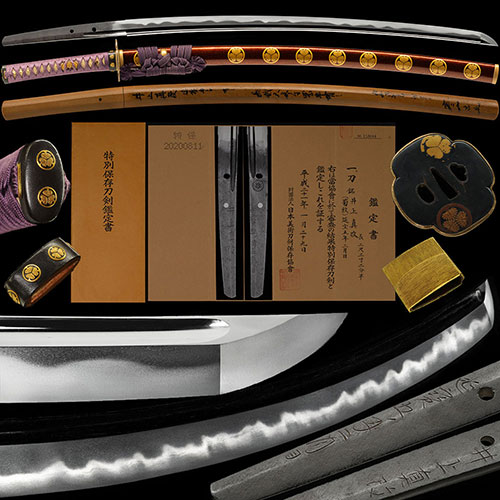
真改 刀Shinkai Katana
No.439013井上真改 菊紋 延宝五年二月日 葵紋散金梨子地塗鞘拵付 金筋頻りに掛り沸匂深く地刃冴え渡る重要レベル最高傑作 二尺三寸二分Inoue Shinkai Kikumon February day of the 5th year of Enpou Aoi-mon Chirashi Kinnashiji Nurisaya-Koshirae Kinsuji-shikirini-kakari Deep Nie Nioi Jiba is clear Juyo level masterpiece 70.4cm
ご成約Sold
- 銘表Mei-Omote
- 井上真改井上真改 Inoue Shinkai
- 裏銘Ura-mei
- 菊紋 延宝五年二月日菊紋 延宝五年二月日 Kikumon February day of the 5th year of Enpou
- 登録証Registration
- 大阪府 Osaka 昭和40年11月16日 11/16/40(Showa)
- 時代Period
- 江戸時代前期Early Edo period
- 法量Size
-
刃長 70.4cm (二尺三寸二分) 反り 1.9cm
元幅 3.1cm 先幅 2.2cm 元重 0.71cm 鎬厚 0.72cm 先重 0.50cm 鋒長 3.6cm 茎長 23.7cm 重量 765gHachou 70.4cm (二尺三寸二分) Sori 1.9cm
Moto-Haba 3.1cm Saki-Haba 2.2cm Moto-Kasane 0.71cm Shinogi-Thikess 0.72cm Saki-Kasane 0.50cm Kissaki-Chou 3.6cm Nakago-Chou 23.7cm Weight 765g - 国Country
- 山城Yamashiro
- 姿Shape
- 鎬造、庵棟、身幅広く、反り深く、中鋒。Shinogidukuri, Iorimune, Wide Mihaba, Deep Sori, Chu-Kissaki
- 鍛Kitae
- 小板目肌に小杢目肌交えよくつみ、板目・杢目交じり、地沸微塵に厚く付き、地景細かく頻りに入り、鉄明るく冴える。Small-Itamehada, Mixed Small-Mokume-hada-tsumi, Itame and Mixed Mokume, Jinie entered thickly, Chikei entered finely well, Iron is clear and bright.
- 刃文Hamon
- 大互の目乱れ、互の目交じり、濤欄風となり、足太くよく入り、小沸深くよくつき、砂流しかかり、金筋長く頻りに掛り、匂深く、匂口明るく冴える。Oh-Gunome-Midare, Mixed Genome, To-ran-style, Ashi entered thickly, Small-Nie deeply entered, Sunagashi-kakari, Long Kinsuji-shikirini-kakari, Deep Nioi, Nioikuchi is bright and clear.
- 帽子Boushi
- 直に小丸、先掃きかけ深く返る。Suguni-Komaru, Sakihakikake-Fukaku-kaeru
- 茎Nakago
- 生ぶ、先栗尻、鑢目筋違化粧、目釘孔二。Ubu, Sakikurijiri, Yasurimesujikai-Kesyou, Mekugiana are two(2)
- ハバキHabaki
- 金着二重。Double Gold
- 拵Sword mounitings
- 金梨子地塗葵紋散鞘打刀拵
法量
長さ100.3cm 反り3.7cm
説明
鐔 赤銅磨地葵紋金蒔絵木瓜形、 目貫 葵紋三双金色絵、 縁頭 赤銅石目地葵紋散金色絵。 小柄 赤銅磨地葵紋二双。Kinnashiji-nuri Aoi-mon Chirashi saya Uchigatana Koshirae
Length: 100.3cm
Sori:3.7cm
Tsuba:Syakudou Migakiji Aoimon Kinmakie Mokkou-gata
Menuki: Aoimon Sans Kiniroe
Fuchigashira: Syakudou Ishimeji Aoi-mon Chirashi Kiniroe
Koduka: Syakudou Migakiji Aoimon Nisou
- 説明Drscription
- 真改は、名を井上八郎兵衛といい、寛永7年(1630年)、初代国貞の次男として日向国木花村木崎にて生まれ、9歳より当時京都に居た父の下に赴き作刀を学び始め、20歳ごろには盛んに父の代作を行ったと云われている。慶安5年(1652年)24歳で父の死去に伴い国貞を襲名、同年に「和泉守」を受領、万治四年頃に朝廷より菊紋を茎に切ることを許され、寛文12年(1672年)8月より「真改」と名を改め、銘を「井上真改」と切るようになる。10年後の天和二年に五十三歳で急逝した。この刀は、真改47歳の作で、この頃重要文化財・重要美術品指定の作品が生まれた最高の時期となる。身幅広く反りの深い優美な姿を呈し、キラキラと輝く大小の地沸がびっしりと厚く付き、地景頻りに入る明るく冴えた地鉄に、大互の目華やかに乱れて、濤瀾風となり、金筋長く頻りに掛り、刃中もよく沸えて沸深くつき、極めて匂深く、匂口明るく冴え渡る。重要レベルの最高傑作である。Shinkai, whose name is Hachirobei Inoue, was born in Kizaki, Kuniki Hanamura, Hyuga Province in 1630 as the second son of the first Kunisada. It is said that he began to learn and actively performed a substitute work for his father around the age of 20. Around the 4th year, the imperial court allowed him to cut the chrysanthemum crest into stems, and from August 1672, he changed his name to "Shinkai" and changed his name to "Shinkai". He died suddenly at the age of 53 in the second year of Tenna, ten years later.
This sword was made when Shinkai was 47 years old.and it is the best period when a work designated as Juyo Bunkazai and an Juyo Bijutsuhin was born. Exhibiting a wide Mihaba and graceful figure with a Deep Sori,Glittering large and small Jinie is densely attached, Chikei-shikirinihairu, Jigane is bright and clear, Oh-Gunome Gorgeous Midare. To-ran-style, Kinsuji long-shikirini-kakari, Inthe sword Niete, Deep Tie-tsuki, Deeply Nie well, Nioikuchi is bright and clear. It is a masterpiece of Juyo level.



